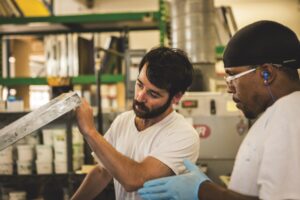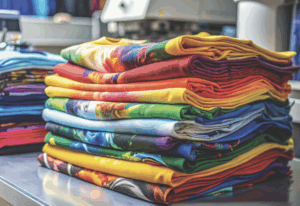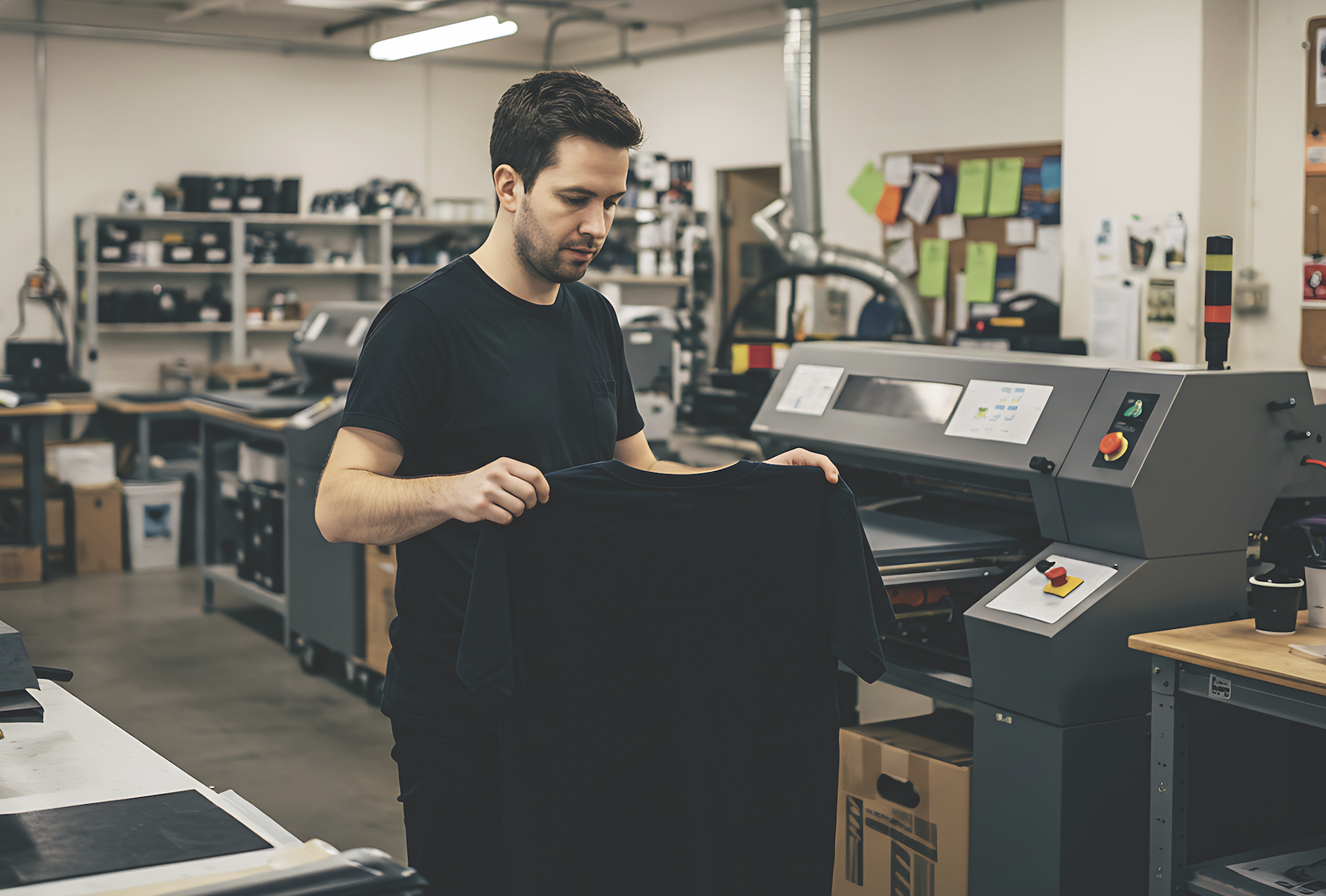8 pro tips to help your custom screen printing, embroidery or heat-press shop conquer high-stakes merch and decorated apparel runs
Upstate Merch (upstatemerch.com) got a call one day from comedian John Mullaney’s people asking if the printer could turn around a huge merch order. “They overnighted 10,000 blanks to us, and we printed and shipped the shirts to the location in a U-Haul,” says owner Dylan Gilligan.
Better still, Gilligan says, “We did them a solid, so we scored the merch orders for the rest of the tour.”
While getting an order like this is exciting, Gilligan says shop owners must understand how to handle the job before saying, yes.
“Many hungry shops jump at the chance to take a 10,000-shirt order they need in a week because the regular printer couldn’t do it,” he says. “As a small to mid-sized printer, it’s easy to get excited about big orders, but the logistics can be overwhelming. You’ve got to know your limits—10,000 hoodies means figuring out boxes, staging space and shipping capacity. If you’re unprepared, the order can quickly outgrow what you can handle.”
That Branded Merch Adrenaline Rush
Hot market printing offers both exhilarating opportunities and substantial challenges for print shops. “We love the challenge of it,” Gilligan says. “Our team is stoked when we say we’re printing for the Buffalo Bills or our favorite band. You also get to put that win on your social media…that’s credibility and reputation right there, and you get more work.”
Case in point, over the years Zome Design (zomedesign.com) has found that hot-market sports championships have boosted sales in slow seasons, like January. When the Eastern Washington Eagles won the 2010 National Football Championship, for example, the shop’s sales skyrocketed for a profitable month. “This gave our employees full-time and overtime work,” says owner Brayden Jessen. “Starting the year profitably means you don’t spend the late spring digging out of a hole.”

Having a strong production team in place is crucial for those shops looking to boost capacity. Photo by Cultura Allies – stock.adobe.com
Like Gilligan, Jessen makes a point of telling news stations and newspapers about these kinds of hot-market printing jobs, especially for local teams. “We receive tons of free publicity across media outlets during primetime and late-night spots,” he says. “Imagine having that many free commercials about your business on several local stations, letting your community know what you’re doing. People see me and say, ‘I saw you on the news! You guys are crushing it!’”
Along these same lines, Marshall Atkinson, principal at Atkinson Consulting (atkinsontshirt.com), where he is also the publisher of the Midjourney newsletter (midjourneyexperience.com), once headed up giant hot-market printing jobs for a number of Super Bowl and Stanley Cup teams while working as the creative director of a print shop.
“It’s a high-pressure situation where your entire team, including front-office staff, works all night to print 30,000 to 50,000 shirts,” Atkinson says. “But we’d have a party atmosphere with pizza and doughnuts. To make it go more smoothly, you must set everything up beforehand, like getting the art approved, burning screens, doing a test print and staging your packing area.”
Rush Decorated Apparel Orders: The Dark Side
While hot-market events are a big score, be warned you might also find yourself putting all kinds of work into an order that doesn’t go through. One time, when the Gonzaga College Bulldogs were in the National Basketball Championship, Jessen brought in 14,000 garments for an “if win,” complete with pre-booked purchase orders for local retailers, an approved design for the shirt in question and even the necessary licensing approvals—all of which would have been for naught if the team itself came up short.
“If the team doesn’t win and we have to ship all the shirts back, it’s a huge bummer,” Jessen says. “Your staff is sitting there on pins and needles, waiting until the end of the game to find out if they’re going to get to print thousands of shirts through the night, or if they’re going home.”

Make sure you’ve got the necessary blank apparel lined up in advance of actually beginning each production run. Image by BrilliantPixels – stock.adobe.com
Staffing can also be a challenge. “If you’re already fully booked, taking on something that has to be produced in a rush can make it hard to keep your current work on track while also taking advantage of the surge in orders,” Jessen says. “You have to take good care of your team, so they don’t burn out. The stress levels can be high, keeping everything on track and hitting deadlines.”
Along these same lines Atkinson emphasizes the fact you need a strong production team to handle big, fast upticks in volume. “If you have a good manager and a solid crew, they’ll make it happen,” Atkinson says. “But if your shop can’t hit targets or handle pressure, you probably shouldn’t take on those big orders.”
Another common pitfall is depending too heavily on a single high-profile client, especially one that frequently places large rush orders. “You get Nike and add four more presses and hire a bunch of people, but then you lose the client,” Gilligan says, noting how his team once had to “snap out of it” after prioritizing a big client to the point where it was starting to neglect a number of smaller accounts. “That bubble pops, and now you just lost 40 other customers,” he says.
Handling High-Volume Rush Custom Apparel Orders
If you’re thinking about taking on larger orders, what follows are some considerations as cited by shops that regularly handle these kinds of jobs.
1) The ebbs and flows of big orders
Since the decorated-apparel industry is seasonal, print shops ideally have the equipment and staffing to scale up their output when the busy season hits. “If you don’t have the added machinery, it can cause bottlenecks and delays,” warns Kyle Robinson, owner of Print My Threads (printmythreads.com). “If you don’t have the staff, it can result in costly overtime and burn out your production crew. You should always build in backups for equipment and people if things don’t go as planned.”
It also helps to know your run rates. “Do time studies over an extended length [of time] to determine an accurate run speed or rate,” Robinson says. “If you think you can run a job at 500 pieces an hour, but with press stoppage, you’re only running at 300 to 350 pieces an hour, that quickly causes bottlenecks and getting behind schedule.”
As you are doing these studies, keep in mind your run rate will typically vary depending on the type of garment you’re printing, the artwork, the person running the equipment and so on. “Whoever is doing your scheduling needs to know this and consider all those variables when scheduling your production,” Robinson says.
Finally, Gilligan suggests shops diversify their client base by handling a mix of small, medium and large orders. “When you get those larger orders, you have a whole section of your business, with equipment and staff, to handle that,” he says. “[Otherwise]. the other side will suffer.”
2) Manage inventory so you’re prepared
Robinson prints for several hospitals that require large runs for Breast Cancer Awareness Month, in October. “If they want pink shirts, we start those conversations in August, so we can secure the stock they need rather than wait until mid-to-late September when everyone’s buying pink garments,” Robinson says.
Since Print My Threads doesn’t maintain any in-house inventory, when a client needs a larger or quick-turn job, he makes a point of limiting the options he offers to styles and colors he knows are going to be available. “For large jobs, when we have time to plan, we’ll ask the customer to commit to buying stock before their numbers are finalized, so we can get what they need,” he adds.
3) Maintain lines of communication
Central to the way it does business, Print My Threads employs a customer portal it requires each and every one of its customers to use. “We custom-built a shop management tool using the online database system Airtable that our team uses to enter in all of the information for each order,” Robinson says. “This system has custom views for each department…to ensure our team has all the info they need for each task, job and order. The info our customers need to see gets pulled from our system and is visible in the portal they use to review, approve, pay and track all their orders.”
In addition to Print My Thread’s primary order management system, Robinson says the team employs an email tool called Missiveapp (missiveapp.com). “Missive is basically like a Slack channel plus a CRM (customer relationship management system) that lives within each customer email correspondence,” he says. “This is super handy and allows our team to work remotely but still have access to all the information they need.”
Similarly, Chris Perry of UTees (universitytees.com) says the company has a “Large Order Playbook” that starts with internal collaboration and a Slack channel dedicated to opportunities that qualify. “The key thing is communication, and it needs to happen early and often with all parties,” Perry says. “We decide whether it makes sense to bid, at what price and what timeframe. Then, we communicate what we can do for our customers. From there, it’s an ongoing conversation about logistics, sampling and so on.”
4) Optimize scheduling and workflow
In addition to having personnel and inventory in place well in advance, a shop handling large orders needs a production management system capable of communicating the exact tasks and sequencing required of every department employee. “You also need a dedicated scheduler,” Robinson explains. “This person acts like a [restaurant] kitchen expeditor, directing what’s needed and when to ensure everything is completed in the right order. They must have in-depth knowledge of an order’s lifecycle to orchestrate and expedite jobs effectively through the shop.”
By way of an example, Robinson says, if you’re decorating thousands of hoodies, each with a front and back print, do you know where these hoodies are going to be kept once the front print has completed and they’re waiting for the back one? Do you have the space/capacity to store them on carts, or do you need to move them to pallets or another staging area so they won’t interfere with whatever else might be going on? And where do they go once the printing is done and they’re waiting to be folded?
“The more time you spend handling the goods or moving things around, the more chance for costly errors and the less profit you’ll make,” Robinson says. “We have a ‘go slow to go fast’ mentality, with a plan for each step before we execute. Everything needs to happen in the right order so there’s a consistent flow of goods in and out of the shop daily.”
5) Address space constraints in your decorating shop
Turning to the basic parameters of your shop, Gilligan emphasizes the fact lack of space can turn, say, a rush 10,000-shirt band merch order from a great business opportunity to a nightmare. “If you already do merch and have those 10,000 black shirts in inventory, it’s easy,” he says. “When you don’t keep inventory, you have to order 10,000 shirts and hope they arrive. Do you actually have room for 10 pallets in your shop when they arrive? Then, if the order is for two to three print locations per shirt, you need to move the skids around to print all the shirts multiple times.”
6) Ensure quality control at all times
As is—or should be—the case with every order, the process for keeping quality consistent over thousands of items starts before the ink hits the first shirt. “Printing is the easy part—it’s all in prepress and proofing,” Gilligan says. For big orders, like 10,000 pieces, his team uses on-press proofing with photo and physical samples to ensure every detail is spot on. “You don’t want to be on the hook for 10,000 shirts with a mistake,” he says.
In addition, there’s the very real challenge that comes in the finishing touches in the wake of actual printing, Gilligan says. Barcoding, labeling, bagging—getting all that right takes laser focus, with many hot-market items needing even more care in the form of specific quantities of each size neatly packed and ready to go.
With this kind of precision in mind, Robinson says Print My Threads uses a color-coded sticker system so that its production team can quickly and easily communicate if something is wrong. For example, the staffer pulling uses a sticker dispenser at the front of the dryer: Pink = Damaged/Hole, Yellow = Misprint, and Blue = Stain.
“There’s a corresponding chart next to the sticker dispenser and a chart on the table for our catcher to reference, so that anything with a sticker can go in a separate stack and either be counted as spoilage or fixed at our spray-out station,” Robinson says. “We also stack or box in 10’s vs. dozens, because it’s easier for our staff and customers to count stacks of 10 vs. a dozen.”
7) Plan for unforeseen production challenges
No matter how good your shop’s ordering and workflow processes, Gilligan emphasizes the fact a shop needs to be prepared for any kinds of production challenges that may arise, such as managing inks and ensuring proper staffing levels. “Do you have the right ink? I keep 10 five-gallon buckets of white ink on hand, just in case,” he says, stressing that custom colors may require constant mixing during production. “A lot of people don’t think about all of that.”
Before taking on a large order, he also recommends doing a thorough assessment of the state of your shop using a checklist: “Can we fit this? Do we have a loading dock, enough ink, screens and extra hands on-deck?”
Finally, Gilligan suggests holding a candid team discussion before committing to a big job. “Huddle with the team,” he says. “Ask, ‘Do you want to take this on?’ Sometimes, this job is not worth taking because we’ll face burnout or even a mutiny if we’re not all on the same page.”
8) Be realistic about your print shop’s capabilities
When managing high-volume orders, preparation and realistic scheduling are musts. Gilligan also emphasizes the importance of balancing rush orders with any other existing commitments you might have. “Can I move current customers around, or will I hurt them?” he says, noting that accommodating rush jobs without jeopardizing existing deadlines can be a delicate balance. “If you’re decent, you’re already booked two to three weeks in advance.”
Bottom line: taking an order of 5,000 shirts can stretch a shop’s resources, even in a shop with multiple presses. “You can get it done with one or two autos, but it’ll be tight,” Gilligan says, emphasizing the importance of realistically assessing whether your shop has the space, people and capacity to handle a huge rush order without affecting the quality or deadlines for other projects.
Look Before Making that Big Order Leap
Shops that handle high-volume orders typically already have the necessary capacity to maintain a steady flow of large-scale production. “Some shops run two shifts, have 14 autos and crank out 1 million shirts a month,” Gilligan says. “They’re always feeding the beast with a stream of huge orders. If your current shop setup can’t handle it, it may not be worth doing if you put good customers to the side or load up overworked employees.”
At the end of the day, if you aren’t yet set up to manage a hot-market merch pace, it may be best to put this kind of business on hold until you are. It’s important to recognize your strengths and focus on what you can deliver efficiently. By knowing your limits and scaling smartly, you can gradually build the infrastructure needed to take on larger orders without compromising quality, customer relationships or your team’s well-being.
Nicole Rollender is an award-winning writer and heads up the copywriting and content-creation firm strandwritingservices.com. For more information or to comment on this article, your can reach Nicole at strandwritingservices.com.
Updated 7/23/25





